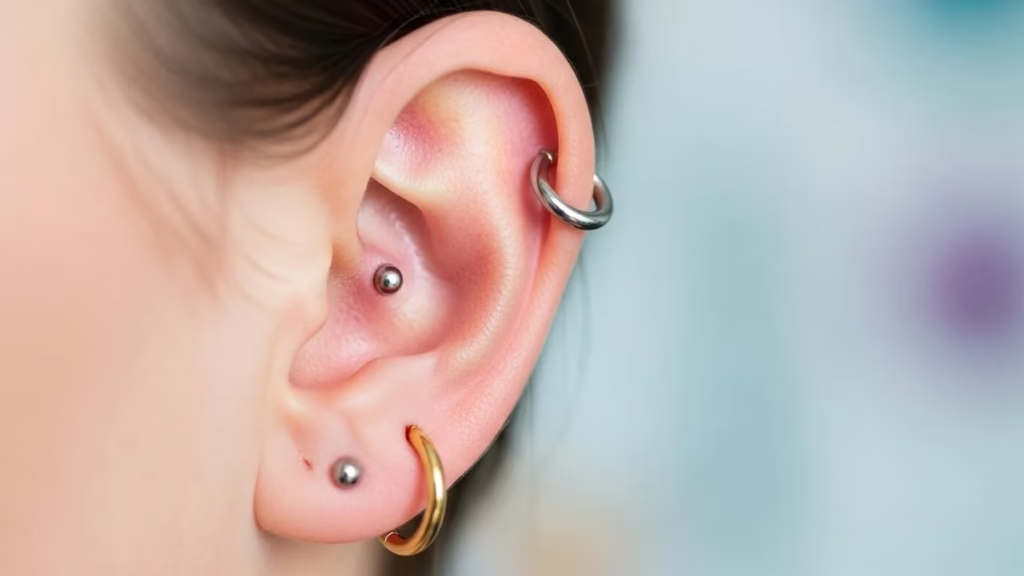Introduction
Body piercings have become more than just a fashion trend—they are a form of self-expression, style, and identity. Among the most popular cartilage piercings today is the conch piercing, admired for its unique placement and versatility in jewelry options. Whether you are thinking of getting your first cartilage piercing or adding to your collection, the conch is a bold yet elegant choice.
In this detailed guide, we’ll cover everything you need to know about conch piercings—including types, pain levels, cost, healing stages, aftercare, risks, and jewelry styles—so you can make an informed decision.
What is a Conch Piercing?
A conch piercing is a type of ear cartilage piercing located in the middle part of your ear, known as the “concha.” The name comes from the ear’s resemblance to a conch seashell. This piercing can be styled with studs, hoops, or statement jewelry, making it one of the most versatile choices.
Types of Conch Piercings
There are two main types:
- Inner Conch Piercing – Placed in the center of the ear’s cartilage, close to the ear canal.
- Outer Conch Piercing – Located on the flat cartilage between the ear’s outer rim (helix) and inner cartilage.
Both styles create unique looks and can be personalized with different jewelry designs.
Does a Conch Piercing Hurt?
Pain is one of the most common concerns. Since the conch involves piercing through thick cartilage, the pain level is moderate to high compared to earlobe piercings.
- On a pain scale of 1–10, most people rate conch piercing pain between 6 and 8.
- The inner conch usually hurts slightly more than the outer conch because of its depth.
- The sharp pain lasts only a few seconds, followed by soreness that can linger for days to weeks.
Tip: Breathing deeply and choosing an experienced piercer can significantly reduce discomfort.
Healing Process of a Conch Piercing
Healing time varies depending on aftercare and your body’s response. On average:
- Initial healing: 6–9 months
- Full healing: Up to 12 months
Healing Stages:
- Week 1–2: Swelling, redness, and mild tenderness are normal.
- Month 1–3: The piercing begins to settle, but avoid changing jewelry.
- Month 4–9: Noticeable improvement; irritation may occur if snagged.
- Month 9–12: Piercing fully heals if proper aftercare is followed.
Aftercare Tips for Conch Piercing
Proper aftercare is the key to preventing infections and speeding healing.
✅ Clean Twice Daily: Use sterile saline solution or a piercing aftercare spray.
✅ Avoid Touching: Do not twist or remove jewelry during healing.
✅ Sleep Carefully: Try sleeping on the opposite side to avoid pressure.
✅ No Swimming (Initially): Avoid pools, hot tubs, and lakes for at least 6 weeks.
✅ Choose Hypoallergenic Jewelry: Titanium or surgical steel is recommended for sensitive skin.
⚠️ Avoid alcohol-based cleansers, hydrogen peroxide, or excessive cleaning, as these can delay healing.
Cost of a Conch Piercing
The price depends on location, piercer experience, and jewelry choice. On average:
- USA/UK: $40 – $100 (excluding jewelry)
- India: ₹2,500 – ₹6,000
- Worldwide average: $50 – $90
Premium jewelry like gold or diamond studs will raise the total cost.
Risks & Complications
Like all piercings, conch piercings come with risks. Being aware helps you prevent issues.
- Infections: Caused by bacteria, poor hygiene, or improper aftercare.
- Keloids/Scarring: Some people are prone to raised scar tissue.
- Swelling & Irritation: Often from sleeping on the piercing or snagging it.
- Migration/Rejection: Rare, but jewelry may shift or be pushed out.
Tip: Choose a professional piercer who uses sterilized equipment to minimize risks.
Best Jewelry Options for Conch Piercing
Jewelry plays a huge role in how your piercing looks and feels.
Popular Styles:
- Studs: Great for healing and minimal snagging.
- Hoops/Rings: Stylish once fully healed.
- Cuffs & Clickers: Perfect for bold, statement looks.
- Gemstones or Diamonds: For a luxurious touch.
Recommended Materials:
- Titanium (lightweight & hypoallergenic)
- Surgical steel (durable & affordable)
- Solid gold (luxury option, won’t tarnish)
Conch Piercing vs Other Ear Piercings
Wondering how it compares to other popular cartilage piercings?
| Piercing Type | Pain Level | Healing Time | Jewelry Options |
|---|---|---|---|
| Earlobe | 2/10 | 6–8 weeks | Studs, Hoops |
| Helix | 5/10 | 6–9 months | Hoops, Studs |
| Conch | 6–8/10 | 6–12 months | Studs, Hoops |
| Tragus | 6/10 | 6–12 months | Studs, Bars |
| Daith | 7/10 | 6–12 months | Hoops, Rings |
This shows that conch piercings are moderately painful but worth it for the stylish look.
Frequently Asked Questions (FAQs)
1. How long before I can change my conch jewelry?
At least 6–9 months; changing too early can cause infections.
2. Can I sleep on my conch piercing?
It’s best to avoid sleeping on it until fully healed. Use a travel pillow for comfort.
3. What should I do if my piercing gets infected?
Clean with saline solution and consult a professional piercer or doctor if symptoms worsen.
4. Is conch piercing safe?
Yes, if done by a licensed piercer with sterile equipment.
5. Can I wear earbuds with a conch piercing?
Avoid earbuds during healing. Use over-the-ear headphones instead.
Check here more health tips : Facial Treatment: Types, Benefits, Risks, and Guide .
Conclusion
A conch piercing is more than just a stylish ear accessory—it’s a bold form of self-expression that can complement any look. While it comes with moderate pain and a long healing process, proper aftercare and professional piercing can ensure a smooth journey. From studs to hoops, this piercing opens up endless jewelry possibilities for those who want to make a statement.
If you’re ready to take the plunge, choose a reputable piercer, follow aftercare instructions, and enjoy the unique beauty of your conch piercing.







